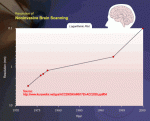Book Review: The Singularity is Near
Ray Kurzweil makes other futurists look like dilettantes. While they are extending linear trends a few years into the future, Kurzweil is using exponential graphs that indicate to him that truly profound changes await us in the next few decades. While other futurists are predicting the graying of developed countries and increased demand for orthopedic implants, Kurzweil expects human/computer hybrids to be here within a few decades. Notably, he predicts that a confluence of technologies – genetics, nanotechnology, and robotics – will create profound changes in virtually every aspect of human life. The “singularity” referred to in the title is “the merger of our biological thinking and existence with our technology, resulting in a world that is still human, but that transcends our biological roots.”
One of the areas Kurzweil dwells on in The Singularity is Near is reverse engineering the human brain. While some scientists have stated that we’ll never fully understand the human brain due to its complexity, Kurzweil thinks we aren’t all that far away from achieving that understanding. He’s got some exponential projections here, too. A plot of the resolution of noninvasive brain scanning shows more or less exponential improvement since 1970, as shown in the first graph.
 As we achieve finer and finer resolutions from scanning techniques that don’t require getting inside the skull, we’ll increasingly be able to better understand the details of brain processes and how things happen at various structural levels. One point Kurzweil makes is that understanding how the brain works requires studying the brain and modeling it at the right level. While in some cases understanding the details of synaptic reactions may be important, in other cases it may make more sense to model a brain region without regard for the detailed neurochemistry that underlies the activity of that region.
As we achieve finer and finer resolutions from scanning techniques that don’t require getting inside the skull, we’ll increasingly be able to better understand the details of brain processes and how things happen at various structural levels. One point Kurzweil makes is that understanding how the brain works requires studying the brain and modeling it at the right level. While in some cases understanding the details of synaptic reactions may be important, in other cases it may make more sense to model a brain region without regard for the detailed neurochemistry that underlies the activity of that region.
 ]At the same time that brain scan resolution is improving, the time to construct brain scan images is coming down. Kurzweil also plots exponential improvement here, too, showing that what took 1000 seconds in the early 1970s now takes well under a hundredth of a second.
]At the same time that brain scan resolution is improving, the time to construct brain scan images is coming down. Kurzweil also plots exponential improvement here, too, showing that what took 1000 seconds in the early 1970s now takes well under a hundredth of a second.
Ultimately, Kurzweil thinks that nanobots will be the most popular and effective brain scanning tool, probably by the 2020s. Kurzweil’s projected nanobots are tiny robots, about the size of a human blood cell, that will travel through the smallest brain capillaries and send back data via a wireless network.
If you think this sounds like science fiction, wait until you get to the part about human intelligence expanding to fill the universe at the speed of light… Kurzweil concludes this fat volume with a chapter devoted to rebutting arguments that have been raised against his vision of the future.
Will the future unfold as Kurzweil predicts? Probably not – even the smartest forecasters and futurists never get it completely right, often because it’s hard to guess the future when there are major intermediate steps that don’t correspond to current experience very well. While someone might have predicted the falling size and increasing power of personal computers twenty five or thirty years ago, they would have been hard pressed to pick word processing and spreadsheets as the major applications, much less Web browsing. Once a technology is created, humans tend to find new and unexpected uses for it. If we do develop nanobots, we may well see them used in ways that differ greatly from what Kurzweil expects.
If you want a book that will shake up your thinking about what might happen in the next two or three decades, give Singularity a try. You may not buy into every thesis in the book (and there are plenty of them!), but Kurzweil will get you thinking about what might be possible. And even if you don’t believe he’s right about what will happen in 2045, his projections on technology changes may help you figure out what will likely happen in 2010 or 2015.
From a neuromarketing standpoint, Kurzweil’s projections for noninvasive brain scanning (and the general process of understanding how our brain works) suggest an optimistic future in the near term. Better scan resolution in both the space and time dimensions will give neuromarketers better data, and, one hopes, cheaper and more convenient data. (Then again, a few years farther into the future, and we’ll probably be using some combination of electronic intelligence and the human brain to decide what to purchase. Creating a marketing pitch may become a highly technical pursuit not unlike structuring content to be ranked for specific keywords in Google. Today we have search engine optimization – in 2025, we may have hybrid brain appeal optimization. :))
